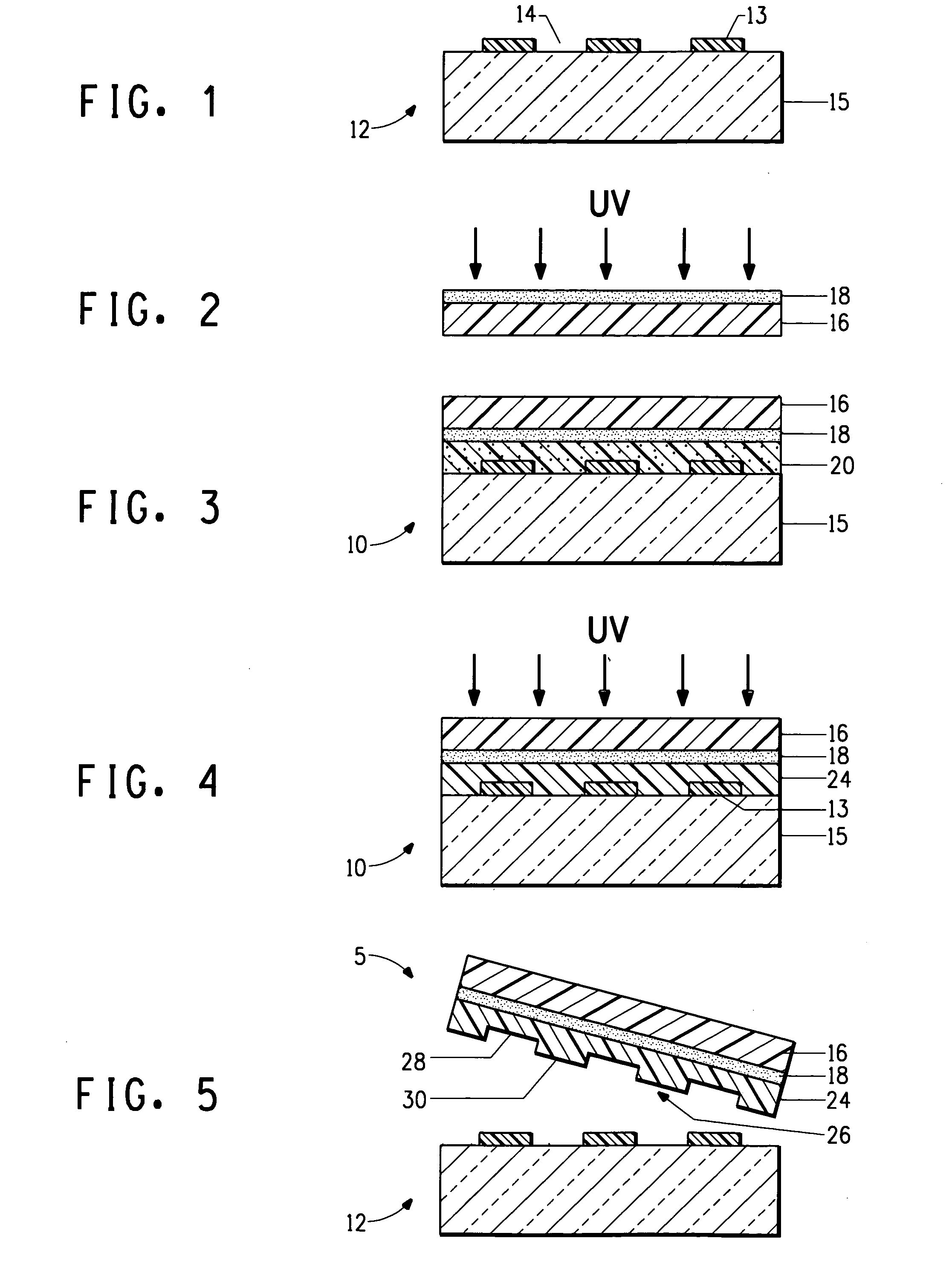Printing form precursor and process for preparing a stamp from the precursor
a technology of precursor and printing form, which is applied in the field of printing form precursor, can solve the problems of pdms severely limiting its capabilities, inability to easily control the surface energy of pdms, and breakage of the polymer chain
- Summary
- Abstract
- Description
- Claims
- Application Information
AI Technical Summary
Problems solved by technology
Method used
Image
Examples
example 1
[0067]The following example demonstrates the preparation of a stamp made of a photosensitive composition having a polyfluoropolyether (PFPE) and a fluorinated photoinitiator.
[0068]A polyfluoropolyether compound according to Formula 1A, D20-DA diacrylate, was prepared by the following procedure. A solution of FLK-D20 Diol purchased from Solvay Solexsis (Thorofare, N.J.) (10 gr, 0.005 mol, 1 eqv.) and BHT (1 wt % FLK-D20 0.001 gr) in anhydrous THF (100 ml) was allowed to stir in a 3-neck round bottom reaction flask (250 ml) equipped with a dropping funnel, thermometer, condenser and N2 purge adapter. The reaction flask was cooled down to 0° C. using an ice-water bath. Triethylamine (1.948 gr, 0.0193 mol, 3.85 eqv.) was added dropwise to the solution of FLK-D20 Diol in THF over a 15 minute period. The reaction was maintained at 0° C. A second dropping funnel charged with acryloyl chloride (1.585 gr, 0.0185 mol, 3.5 eqv.) was added dropwise to the solution over a 60 min period. The temp...
example 2
[0077]The following example demonstrates the preparation of a stamp made of a polyfluoropolyether composition with a non-fluorinated photoinitiator.
[0078]The polyfluoropolyether compound, D20-DA diacrylate, was prepared as described in Example 1. The plate composition was prepared by mixing 1 weight % of a non-fluorinated photoinitiator, Darocur 4265, (from Ciba Specialty Chemicals, Basel, Switzerland) illustrated below with the D20-DA. Darocur 4265 is a 50 / 50 mixture of the two structures shown in (a) and (b). The mixture was stirred for 24 hours at room temperature.
[0079]The non-fluorinated photoinitiator was immiscible in the PFPE pre-polymer compound, rendering an non-homogenized mixture. The non-homogenized mixture was then used to make PFPE stamp following the procedure described in Example 1.
[0080]The relief surface of the stamp was characterized by optical micrograph. The micrograph showed good 10 micron dot and line features and many bubbles. The bubbles were defects in som...
examples 3 and 4
[0082]The following examples demonstrate the difference in dimensional stability of stamps prepared with and without a support.
[0083]Both stamps were prepared using a 4 inch (10.16 cm) Silicon (Si) wafer as a master since it provided a highly flat and uniform surface.
[0084]The stamp of Example 3 was prepared according to Example 1, except that the stamp did not include the Melinex® 561 polyester support. The layer was exposed (through the side opposite the master) in a nitrogen box for 10 min at the I-liner wavelength of 365 nm. The thickness of the cured stamp was about 1.5 mm. The layer cured to form a stamp without a support (i.e., freestanding stamp) but delaminated from the master during the curing process and was largely deformed.
[0085]The stamp of Example 4 was prepared according to Example 1, except that the stamp included a support. After the mixture was poured onto the master, a 5 mil Melinex® 561 polyester support having the adhesive layer as described in Example 1 was ap...
PUM
| Property | Measurement | Unit |
|---|---|---|
| thickness | aaaaa | aaaaa |
| thickness | aaaaa | aaaaa |
| wavelengths | aaaaa | aaaaa |
Abstract
Description
Claims
Application Information
 Login to View More
Login to View More - R&D
- Intellectual Property
- Life Sciences
- Materials
- Tech Scout
- Unparalleled Data Quality
- Higher Quality Content
- 60% Fewer Hallucinations
Browse by: Latest US Patents, China's latest patents, Technical Efficacy Thesaurus, Application Domain, Technology Topic, Popular Technical Reports.
© 2025 PatSnap. All rights reserved.Legal|Privacy policy|Modern Slavery Act Transparency Statement|Sitemap|About US| Contact US: help@patsnap.com



